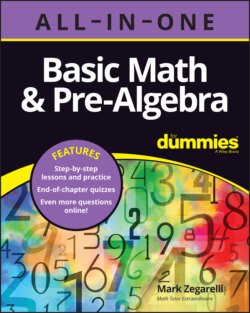Читать книгу Basic Math & Pre-Algebra All-in-One For Dummies (+ Chapter Quizzes Online) - Mark Zegarelli - Страница 55
Understanding Where Negative Numbers Come From
ОглавлениеWhen you first discovered subtraction, you were probably told that you can’t take a small number minus a greater number. For example, if you start with four marbles, you can’t subtract six because you can’t take away more marbles than you have. This rule is true for marbles, but in other situations, you can subtract a big number from a small one.
In real-world applications, negative numbers can represent debt. For example, if you have only five chairs to sell but a customer pays for eight of them, you owe them three more chairs. Even though you may have trouble picturing −3 chairs, you still need to account for this debt, and negative numbers are the right tool for the job.
As another example, if you have $4 and you buy something that costs $6, you end up with less than $0 dollars — that is, −$2, which means a debt of $2.
A number with a negative sign in front of it, like −2, is called a negative number. You call the number −2 either negative two or minus two. Negative numbers appear on the number line to the left of 0, as shown in Figure 4-1.
FIGURE 4-1: Negative numbers on the number line.
When you don’t have a number line to work with, here’s a simple rule for subtracting a large number from a small number: Switch the two numbers around and take the small number from large number; then attach a negative sign to the result.
Q. Use the number line to subtract 5 − 8.
A. −3. On the number line, 5 − 8 means
Q. What is ?
A. −8. Because 11 is less than 19, subtract , which equals 8, and attach a negative sign to the result. Therefore, .
1 Using the number line, subtract the following numbers:
(a)
(b)
(c)
(d)
2 Find the answers to the following subtraction problems:
(a)
(b)
(c)
(d)
